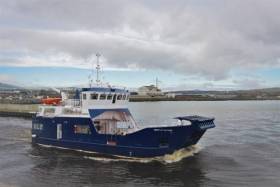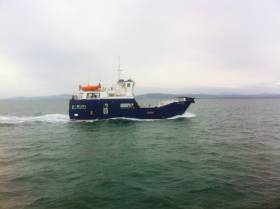Displaying items by tag: Spirit of Rathlin
#NewFerryArrives - Residents of Rathlin Island now have an exciting addition as a brand new car ferry arrived this morning which is to serve the North’s only inhabited island, writes Jehan Ashmore.
After a 20 hour delivery voyage from boatbuilders Arklow Marine Services, the Spirit of Rathlin sailed into Church Bay. The main harbour of the island which has a population of around 150.
Crew of existing fast-craft ferry, Rathlin Express sailed out of Church Bay to welcome Spirit of Rathlin off Rue Point. A sight that was breathtaking for the operator to see as both vessels approached Rathlin in unison. By coincidence Rathin Express (see artists sketch) with a capacity just shy of 100 passengers was also built by AMS back in 2009.
Spirit of Rathlin was commissioned by the Department for Infrastructure (Dfi) at a cost of £2.8m and through a tendering process a contract was awarded to Rathlin Ferry Co. The new vessel will enhance operations for both islanders and for tourists exploring the delights of the 'Causeway' coast.
The tender contract is for a duration of a decade that is to see the new six vehicle ferry ply the Sea of Moyle. This six mile stretch of water separates the island and Ballycastle. The harbour on the mainland is located on the equally stunning Antrim coast.
The presence of Spirit of Rathlin will not mean immediate service as sea trials at both harbours will firstly have to take place. In the meantime routine sailings are operating.
Vehicles using Spirit of Rathlin will involve the ferry's bow-loading ramp, however only islanders can take their cars on board.
As for the 140 passengers, they will be accommodated in a much larger superstructure compared to carferry Canna. This veteran vessel which has its origins in Scotland, having been built in 1976 for Caledanian MacBrayne (CalMac). They had operated the Rathlin service until 12 years ago and Canna will be replaced by the island's first custom-built carferry.
Last month Afloat reported on the unique arrival of Spirit of Rathlin into Greystones Harbour, as this enabled the 28m long newbuild to carry out the first ever trials of using the bow door. This took place at the boat slip that saw a car embark via the vessels ramp. The exercise was shortly followed by a van.
#FerryCompleted - Spirit of Rathlin the new £2.8m car and passenger ferry is to be operated under a new ten year contract awarded to Rathlin Island Ferry Ltd, writes Jehan Ashmore.
The newbuild built by Arklow Marine Services undertook sea trials last year and is to replace an ageing ‘Island’ class ferry the Canna on the Ballycastle-Rathlin service. This former CalMac ferry dating to the 1970's has served alongside the passenger only catamaran Rathlin Express, also constructed at the Co. Wicklow shipyard owned by the Tyrrell family.
Spirit of Rathlin was contracted to AMS by Northern Ireland’s Infrastructure department, whose Minister Chris Hazzard welcomed this week the completion of the ferry.
The Minister said: “I am delighted to announce completion of the new car and passenger ferry for Rathlin Island. This is excellent news for the people of Rathlin and particularly for those who use this essential service to go about their daily business.
"The ‘Spirit of Rathlin’ ferry will ensure that passenger and vehicle services can continue to be provided on this important lifeline route between Rathlin Island and Ballycastle. This new ferry has been designed to modern standards and includes the latest technology for the service it will operate.”
Spirit of Rathlin will come into service once the new £1m harbour to accommodate the newbuild is completed. Following that stage a Passenger Certificate is to be obtained from the Maritime and Coastguard Agency (MCA) to enable the ferry to begin operating.
So what does the Spirit of Rathlin bring to the Co. Antrim route, firstly the stern-only loading vehicle ferry includes a modern passenger lounge. During good weather there is an upper passenger deck to take in this most scenic route of the north coast.
Leinster Seaboard Trials Continue for Arklow Newbuild Northern Car Ferry
#SeaTrials – Off the Leinster seaboard an Arklow built car ferry contracted by Northern Ireland’s Department of Infrastructure continues to carry out sea trials today, writes Jehan Ashmore.
As previously reported on Afloat.ie the Spirit of Rathlin, a 6 vehicle /140 passenger capacity ferry was launched in September by Arklow Marine Services for the Ballycastle-Rathlin Island route.
The twin-screw car ferry with Belfast as a port of registry departed Arklow from where this morning the 28m long vessel with a beam of 8m is currently underway on sea trials.
Earlier this month the identity of the new operator of the Co. Antrim service to use Spirit of Rathlin following a procurement process was according to Dfi to be announced shortly.
It is rare to have an Irish built car-ferry as previously reported when the newbuild was hoisted from the North Quay in Arklow to be lowered into the River Avoca. The yard owned by the famous Tyrrell family whose generations have built small ships and boats at the shipyard stretching to 1864.
The yards founder John Tyrell opened the boatbuilding facility then on the south quays of the river. In more recent years one of the yard's most iconic vessels built was the brigantine Asgard II. This two-masted tallship was the Irish state’s first custom built sail training vessel launched in 1984.
In terms of car ferry construction the yard for example built in 1999 the Ikom K a 4 car / 60 passenger capacity ferry and likewise of Spirit of Rathin ordered for domestic service. The Ikom K though operates for clients in southern waters for owners Murphy Ferry Service linking Castetownbere to Bere Island, Co. Cork.

























